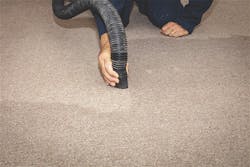Historically powerful storms have inflicted millions of dollars of damage and interrupted the beginning of the 2017-18 school year in Texas, Florida and other parts of the nation.
Aside from obvious physical damage to a facility, storms like Hurricanes Harvey and Irma may do insidious harm to school buildings because of what is left behind when the rain stops and floodwaters subside.
As school workers strive to clean up damaged facilities and make them suitable for students to return, residual moisture may still be present in carpets and flooring and elsewhere in schools where water has penetrated the building interior.
That creates favorable conditions for dangerous mold to grow, often undetected in places such as the underside of carpets and pads. Left unchecked to grow and spread, such mold may cause or exacerbate health problems for staff and students, especially young children and those with asthma.
“There are molds that can grow on almost anything, including wood, paper, carpets, foods, and insulation,” the U.S. Environmental Protection Agency says. “Controlling moisture is the key to managing mold in schools.”
To reduce the chances of mold growth, schools should strive to clean and dry any wet areas in a building within 24 to 48 hours. But that guidance applies to leaks or dampness of a more manageable scope.
When an area is inundated with more than four feet of rain, as was the case in August in parts of the Houston area during Hurricane Harvey, preventing moisture from getting into a school facility or trying to dry areas in a school that have become wet may beyond the means of staff.
In situations like that, the carpeting is likely to be a total loss, and schools should just get rid of it.
“Flood waters are not clean water,” the Texas A&M AgriLife Extension Service says. “Flooded carpets and rugs are best replaced since floodwater may contain contaminants. Flooded carpet pads should always be discarded and replaced.”
For instance, in the Dickinson (Texas) Independent School District, about 30 miles southeast of Houston, several classrooms at Bay Colony Elementary School received about two inches of water damage.
The district is removing the damaged carpet from those classrooms, it said in a news release, and “students and teachers in those areas will return to school with concrete floors until carpet can arrive in October.”
If a school determines that water damage was less severe and a wet carpet can be dried and salvaged, the EPA recommends cleaning it with a wet vacuum or a steam cleaner, then following up with a high-efficiency particulate air (HEPA) vacuum after the material has been thoroughly dried. The contents of the HEPA vacuum as well as water-damaged materials should be disposed of in well-sealed plastic bags.
When a school building has been repaired and cleaned and ready for new carpet to be installed, workers should take steps to make sure the new carpet doesn’t create indoor air quality problems from off-gassing or mold growth.
That means choosing a carpet with low emission of potentially hazardous volatile organic compounds (VOCs).
Schools that have had to discard carpet in recent weeks may need to wait until winter break, when classes are not in session and students are not present for at least several days, to safely install new carpet.
The EPA says that an area where a new carpet is being installed needs to be aired out for at least 72 hours after installation so that any VOCs contained in the carpet, padding or adhesives can dissipate. Such emissions from carpet materials typically are highest when a carpet is installed.
The EPA also cautions against installing carpet over concrete floors with persistent condensation problems because of the higher risks of mold growth.
For similar reasons, carpet is not a good flooring choice for areas near water sources or places that have continual moisture problems, such as the area around drinking fountains or classroom sinks.
Schools also need to make sure that their maintenance program for keeping carpeting clean doesn’t create conditions conducive to mold growth.
Work that generates moisture such as carpet cleaning should not be carried out in humid climates during the summer unless air conditioning or other moisture-removing equipment such as a high-efficiency dehumidifier is available to dry the carpet effectively and prevent conditions that lead to mold growth.
About the Author
Mike Kennedy
Senior Editor
Mike Kennedy, senior editor, has written for AS&U on a wide range of educational issues since 1999.
